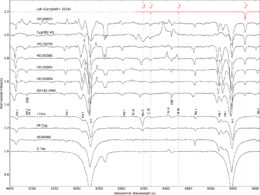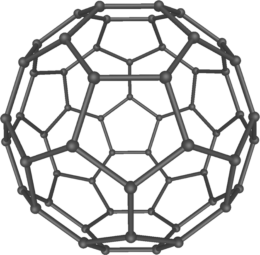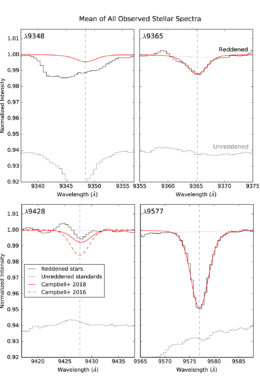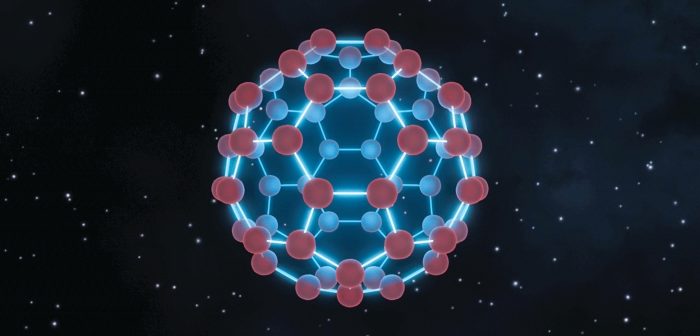From a jumble of confusing clues in Hubble observations of interstellar space, scientists have picked out evidence of a celebrity molecule: ionized Buckminsterfullerene, or buckyballs.
Sorting Out Diffuse Signals
What makes up the tenuous gas and dust that pervades our galaxy, filling the space between stars? What kinds of complex molecules can form naturally in our universe, outside of the potentially contrived conditions of Earth-side laboratories? Where might these molecules form, and how are they distributed throughout space?

Hubble spectra of seven heavily-reddened interstellar sightlines (top seven black lines) and four unreddened standard stars (bottom four lines). The red line at the top indicates a laboratory spectrum for C60+. Positions of the four absorption features associated with C60+ are marked with vertical dashed lines. Click to enlarge. [Cordiner et al. 2019]
These features are not caused by the stars themselves, so they must be due to absorption of light by the diffuse interstellar medium (ISM) between us and the stars. But the jumble of hundreds of features — and the unknown conditions under which they are produced — has made it incredibly challenging to identify the individual molecules present in the diffuse ISM.
A new study led by Martin Cordiner (NASA Goddard SFC; Catholic University of America) presents observations from the Hubble Space Telescope — thus avoiding the additional complication of absorption features from the Earth’s atmosphere — that explore these diffuse interstellar bands further. Hubble’s sightlines toward 11 stars provide confirmation of one special molecule within this jumble: Buckminsterfullerene.

Model of the structure of a buckyball. [Mstroek]
A Celebrity Molecule
The C60+ ion, formally known as Buckminsterfullerene and informally known as a “buckyball”, is an enormous molecule consisting of 60 carbon atoms arranged in a soccer-ball shape. Previously, the largest known molecules definitively detected in the diffuse interstellar medium contained no more than three atoms heavier than hydrogen — so the detection of buckyballs represents a dramatic increase in the known size limit!
Cordiner and collaborators use a novel scanning technique to obtain ultra-high signal-to-noise spectra of seven stars that are significantly reddened by obscuring ISM and four stars that are not. They then search for absorption signals at four wavelengths — 9348, 9365, 9428, and 9577 Å — predicted by laboratory experiments to be associated with C60+.

Mean spectra for the observed sightlines for reddened (black, top) and unreddened (gray, bottom) stars, around four predicted absorption features for C60+. The laboratory comparison spectra for C60+ are overlaid as red lines. [Cordiner et al. 2019]
The consistency of Cordiner and collaborators’ results with prediction provides the strongest confirmation yet of the presence of buckyballs in the diffuse ISM. This detection may help us to characterize other components of the diffuse ISM and better understand the conditions under which complex molecules exist in the extreme, low-density environment of interstellar space.
Citation
“Confirming Interstellar C60+ Using the Hubble Space Telescope,” M. A. Cordiner et al 2019 ApJL 875 L28. doi:10.3847/2041-8213/ab14e5

9 Comments
Pingback: AAS Nova – New
Pingback: Hubble Confirms Interstellar Buckyballs - Sky & Telescope - Worldika - New Platform For Explore World
Pingback: Hubble Confirms Interstellar Buckyballs – Sky & Telescope – AstroBrief
Pingback: Hubble Confirms Interstellar Buckyballs – Sky & Telescope – Dinezh.com
Pingback: Hubble Confirms Interstellar Buckyballs – Sky & Telescope | SPACE FORCE
Pingback: Hubble Confirms Interstellar Buckyballs – Sky & Telescope - monsterbizx
Pingback: Hubble confirma la existencia de buckybolas interestelares – Observatori Astronòmic
Pingback: Mayo 2019 – Observatori Astronòmic
Pingback: Hubble confirma la existencia de buckybolas interestelares « Sección de Astrofísica de la LIADA